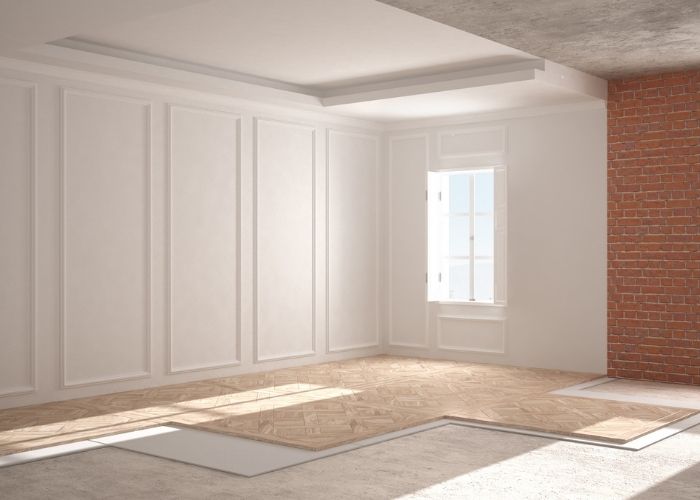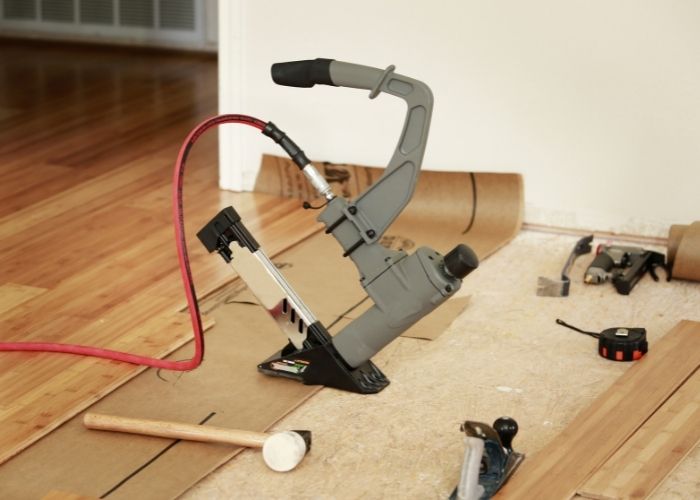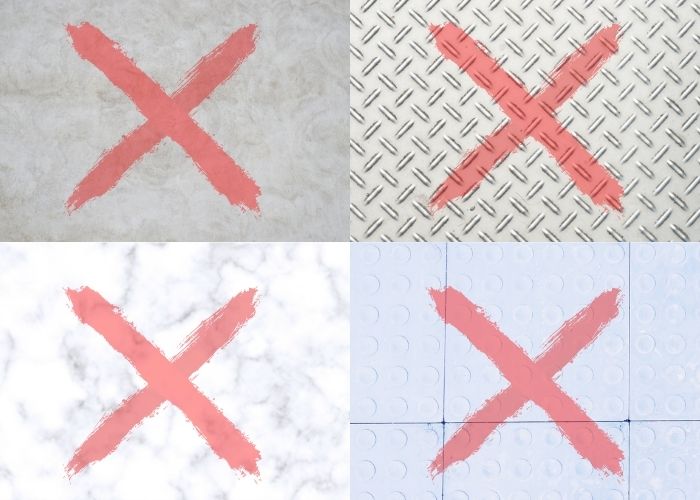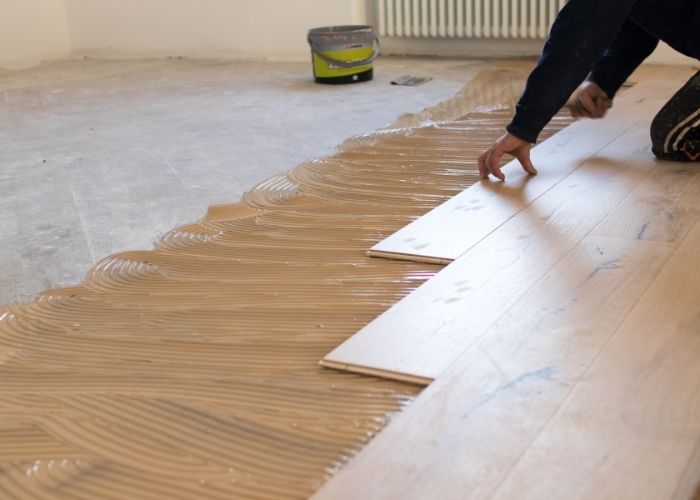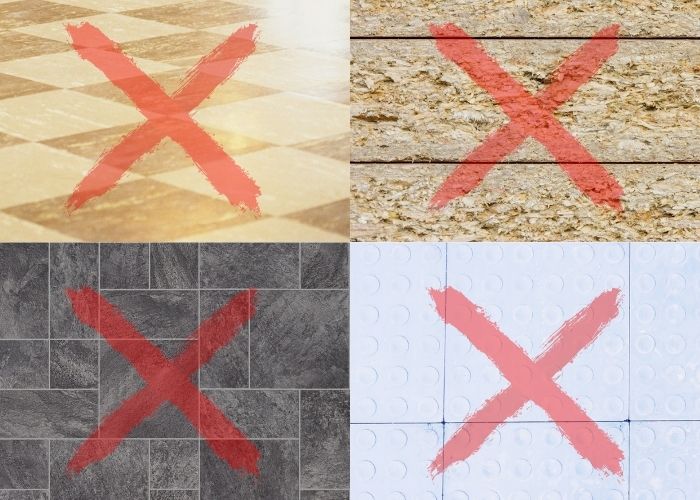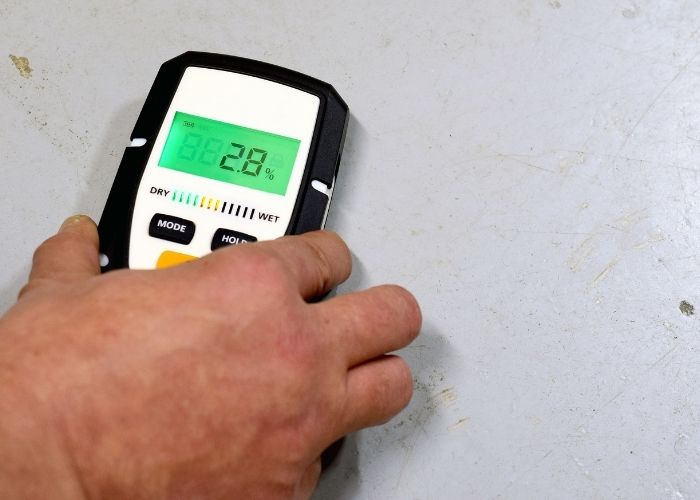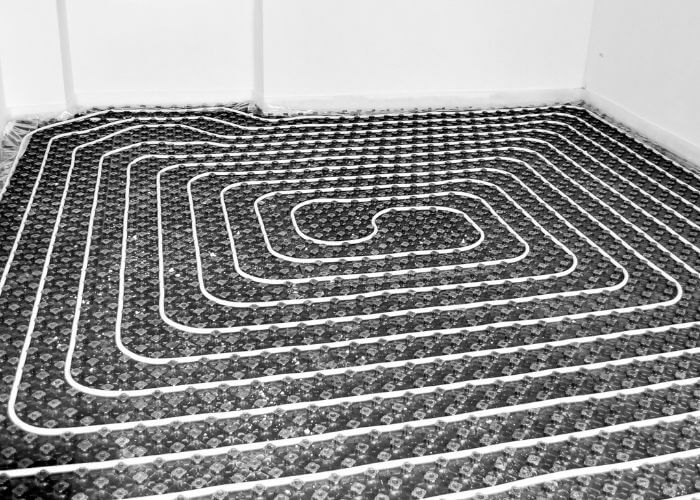Looking to install new bamboo flooring in the near future? There’s more to this home improvement project than simply finding the floor that looks the best. If you want the installation process to go smoothly and provide long-lasting results, your first consideration must be your subfloor. Bamboo flooring, just like most other types of floors, can’t be installed just anywhere. Assessing your subfloor will help you get a few essential tasks crossed off your new flooring checklist:
√ Determine whether solid or engineered flooring is better for your project
√ Choose an installation method: Nail-down, Glue-down, or Floating
√ Figure out which tools and supplies you’ll need (if you’re a DIY-er)
√ Learn how to properly prepare your subfloor
Concrete and existing wood flooring are the most common and stable subfloors. It’s important to note that they also bring their own set of moisture concerns to the party. However, we’re here to tell you exactly what those concerns are and show you how simple it is to address them!
Today, we’re specifically covering the subfloor requirements for solid tongue and groove bamboo flooring.
(If you’re looking to install engineered bamboo flooring, check out our Helpful Guide to Installing Floating Bamboo Flooring.)
Why Your Subfloor Matters
Your subfloor is as important as the flooring on top. Flooring failures occur when you have a subfloor that is in poor condition or not suitable for your chosen installation method. Trying to nail down solid bamboo flooring on an inadequate type of subfloor can waste both time and materials.
The same is true for gluing down solid bamboo flooring onto an unacceptable subfloor. Gluing solid bamboo flooring down to a concrete subfloor that hasn’t been properly sealed is a recipe for disaster. The planks may stay in place for a short amount of time, but eventually, moisture ruins the installation.
In addition, installing solid bamboo flooring over the wrong subfloor or an improperly prepared subfloor can also void your flooring warranty. That means that if/when you have problems with your floors down the road, fixing or replacing them will be on your own dime.
Subfloors for Nailing Down Solid Bamboo Flooring
Let’s start our look at subfloors by laying down (pun intended) the materials that are acceptable and unacceptable for solid bamboo flooring. Nailing down solid bamboo flooring requires just the right type of subfloor. If your subfloor isn’t approved for nail down, you may be able to glue it down – more on that later.
Acceptable Subflooring for Nail-Down Installation
- Advantech OSB
- Plywood (5/8” minimum thickness)
- Existing wood floor (minimum ¾” thickness)
- Firm linoleum (only if installed over plywood)
- Firm kitchen vinyl (only if installed over plywood)
Is your subfloor listed above? Great! You’re good to go with nailing down your solid bamboo floors.
Unacceptable Subflooring for Nail-Down Installation
The following subfloors are not acceptable for nailing down solid floors:
- Concrete
- Gypcrete
- OSB
- Particle board
- Asphalt tile
- VCT vinyl tiles
- Steel
- Ceramic/marble/stone
- Cushion vinyl
- Cement board/backer board/ CBU
- Rubber tile
Did you see your subfloor listed here? Well then, it’s not acceptable for nailing down your solid hardwood or bamboo flooring. Why, you ask? In order for your flooring to be successfully installed, the nails need to penetrate and fasten securely to the subfloor. If the material below your new floors is too hard or too soft, the nails will either not penetrate at all, or will easily come loose.
When it comes to gluing down solid bamboo flooring, things get a bit more complex.
Subfloors for Gluing Down Solid Bamboo Flooring
If your existing subfloor isn’t suitable for a nail-down installation, you may be able to use the glue-down method. This method works with a wider range of subfloors, but some subfloors will need special preparation to make sure the installation is successful and ensures longevity of the floors.
Acceptable Subflooring for Glue-Down Installation
When it comes to acceptable subflooring for a glue-down install, you have a few more options but a few of those have additional caveats. Acceptable subfloors when gluing down solid bamboo floors are:
- Concrete – Slabs must be sealed to prevent moisture. See section further down this article about concrete and moisture.
- Gypcrete (sealed) – Requires sanding with a coarse grit sander to remove the top layer of debris. Then it requires sealing with a dilute coat of acrylic primer. The primer must completely soak in and leave no film. If it does leave a film, your glue will not adhere sufficiently. Once the gypcrete is primed, you can proceed with the installation.
- Plywood* (5/8” minimum)
- OSB* (3/4” minimum)
- Advantech OSB
- Existing wood floors – Must be sanded or scored to ensure that the adhesive will hold to the wood.
- Existing ceramic/marble/stone – Surfaces must be scuffed first to make sure the adhesive will hold to the subfloor.
- Cement board/backer board/CBU
- Steel
*OSB and plywood are acceptable but must meet the minimum thickness specified AND the floor joists must be 16” off-center.
Unacceptable Subfloors for Gluing Down Solid Bamboo Flooring
These subfloors are not acceptable for glued down bamboo flooring:
- Particle board
- Asphalt tile
- Firm linoleum
- Firm kitchen vinyl
- VCT vinyl tile
- Cushion vinyl
- Rubber tile
If your subfloor is listed here and it isn’t suitable for a nail-down installation, another option you might look into is choosing a different type of bamboo flooring. Since solid bamboo flooring must be nailed or glued, you should consider click lock flooring that can be floated.
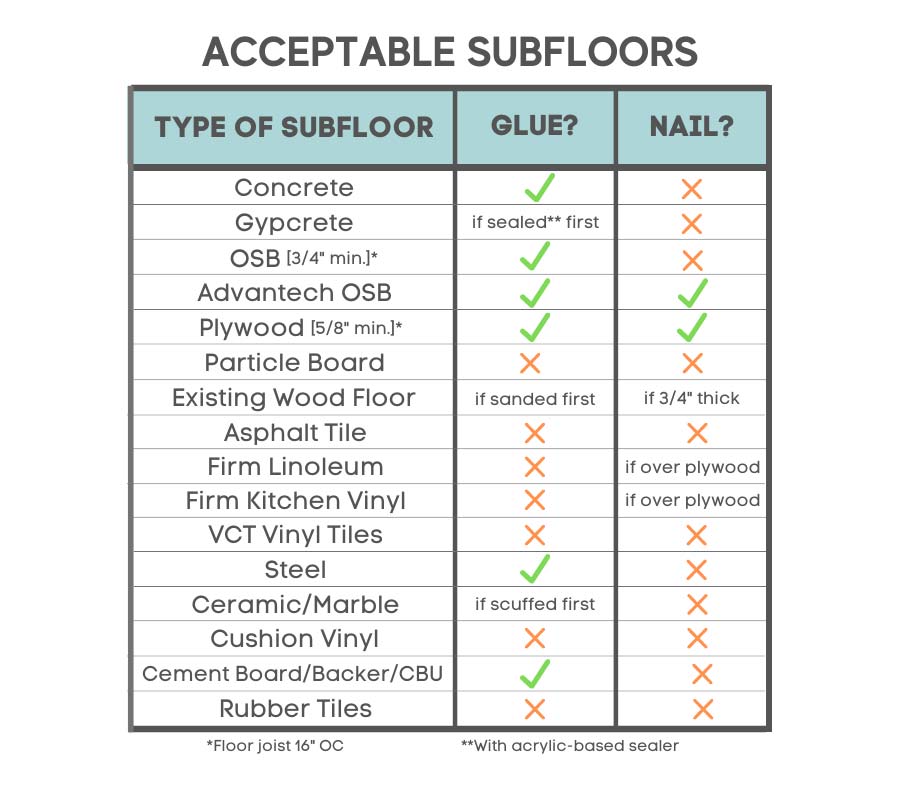
Moisture and Your Subfloor
A leading requirement for any subfloor is that it must be dry, and it must stay dry all year long. Subfloor materials like marble and steel don’t pose moisture problems. Moisture is present, however, in subfloors made of wood, OSB, and cement.
Moisture Content in Wood Floors
The moisture content of a wood subfloor must remain below 12% at all times. Remember that all wood absorbs and releases moisture from the environment. The National Wood Flooring Association recommends that you take about 20 readings per 1,000 square feet and then average the results.
Because your planks are wood and your subfloor is also wood, if they are absorbing and expelling moisture at different rates, you’ll get uneven expansion and contraction. It’s important to acclimate your solid bamboo flooring in the room in which it will be installed and compare the moisture content of your flooring to the moisture content of your subflooring before beginning the installation.
The NWFA provides the following recommendations for moisture content differences between wood flooring and wood subflooring:
- Standard solid plank flooring (less than 3” wide), should have no more than a 4% difference between the acclimated wood flooring and the wood subflooring.
- Wide solid plank flooring (3” or wider), should have no more than a 2% difference between the moisture content in the acclimated wood flooring and wood subflooring.
In the summer, you may need to run an air conditioner and or a dehumidifier to remove excess moisture from wood subflooring. In the winter, a heater can remove excess moisture. Drying the subfloor through ambient temperature control can take up to several weeks so be prepared to be patient.
Moisture Content in Concrete Slabs
Solid bamboo flooring will be damaged by a concrete subfloor that isn’t dry and properly prepared. There – let’s just get that out of the way. Problems with moisture and concrete subfloors are the major reason for the failure of a glued-down floor.
Concrete undergoes a curing process. As it hardens, it absorbs water that it will then slowly release over time. You should not install solid bamboo flooring over a concrete slab until the slab is fully cured for at least 60 days, the moisture levels are checked, a moisture barrier is in place, and you’ve ensured that the moisture present is within the moisture levels of the adhesive to be used.
Concrete subfloors must be sealed with one of the following:
- All-in-one urethane adhesive with vapor barrier
- Concrete sealant
- Reverse vinyl with sufficient moisture barrier.
Do not use red rosin paper or 15 lb. felt paper as a moisture barrier. These materials will not create an adequate moisture barrier for a concrete subfloor.
3 Ways to Test a Concrete Subfloor for Moisture
One of the best ways to avoid moisture issues down the road (when you’re installing over a concrete subfloor) is to test for moisture before installation. There are a few different ways you can perform this test:
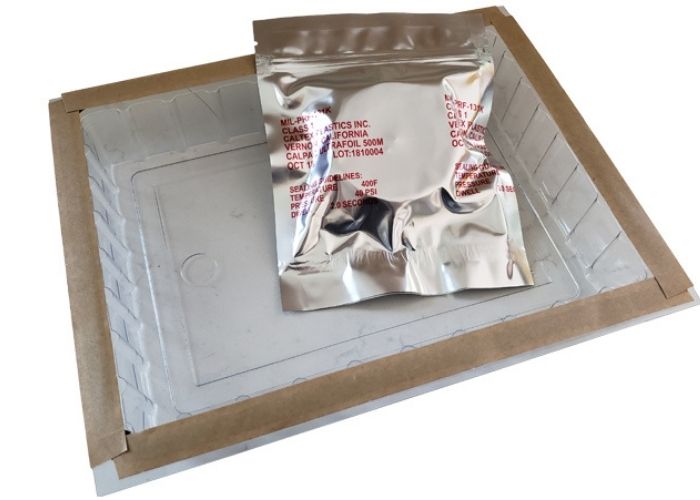
Method #1: Check the moisture level of the slab by taping a plastic sheet to the concrete and after 72 hours, test the moisture in the air under the sheet with a dew point hygrometer.
Method #2: Weigh a package of dry calcium hydroxide, then place it under a plastic sheet taped to the floor. After 72 hours, weigh the package again. Calculate the difference and determine the amount of moisture absorbed.
Method #3: Drill a small test hole in the slab and test it with a dew point hygrometer. Wait 72 hours and test again. The difference in test results will tell you the moisture level.
Fill all cracks and holes with a cementitious patching compound. Also, ensure that the subfloor is level. Be sure that the adhesive to glue the flooring down and the patching compound are compatible.
Subfloors with Radiant Heat
We are often asked if solid bamboo flooring can be installed over a subfloor with radiant heat. You can install solid bamboo flooring over a subfloor with radiant heat provided the subfloor is acceptable for a glue-down installation.
Protect your warranty. Install our solid bamboo floors over radiant heat provided using the glue-down method and a radiant heat-safe, vapor lock adhesive. The glue must be at least 2 mm thick.
Understand that radiant heat under your solid bamboo floors will cause the wood to dry during the heating season. So, expect some shrinkage – that’s normal.
Acclimating Your Subfloor and Flooring with Radiant Heat
If your radiant heat is in concrete, you’ll need to turn the radiant heat system on, set it to the highest temperature, and then leave it at this temperature for 5 to 6 days before you begin the acclimate the wood.
When you bring the flooring in to begin acclimation, be sure to place a 6 mil polyethylene barrier between the concrete subfloor and the boxes of flooring. This prevents the flooring from absorbing moisture from the concrete.
Regardless of the type of subfloor used with your radiant heat, bring the heating system to 65 degrees and then hold that temperature for 24 hours before you bring your solid bamboo flooring into the room to begin acclimation. Use the acclimation process as you would for any other subfloor. Cut open the flooring boxes and stack them for maximum exposure.
Maintain the radiant floor temperature at 65 degrees during the acclimation period, during the installation process, and then for 72 hours after installation is complete.
Cupping and warping happen when you fail to properly acclimate the radiant heat-equipped subfloor and flooring.

About the Author
Cheryl is our go-to guru for all things sustainable living. She’s on a mission to make your family and our planet thrive! With a heart as big as her passion for sustainability, Cheryl brings you the freshest insights on eco-friendly building products and energy efficiency. 🌱💡
And hey, did you hear about the eco-friendly lightbulb that went to therapy? It finally found its inner “enlightenment”! 😄 Join Cheryl on this green journey, where she’ll tackle your concerns with a smile and a sprinkle of eco-humor!

